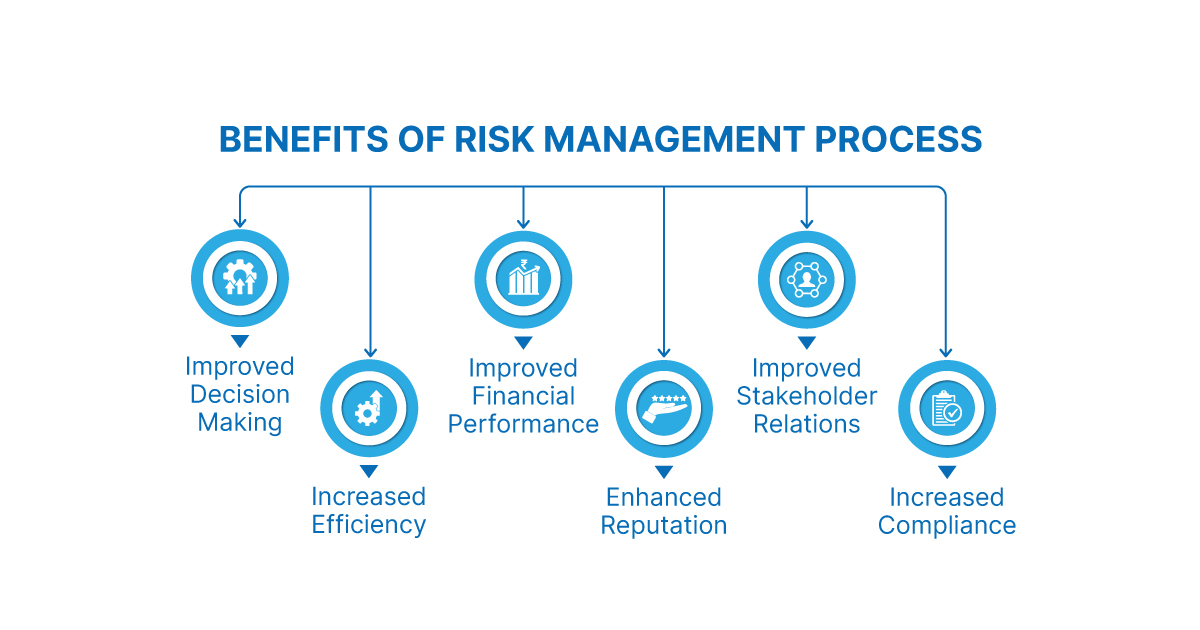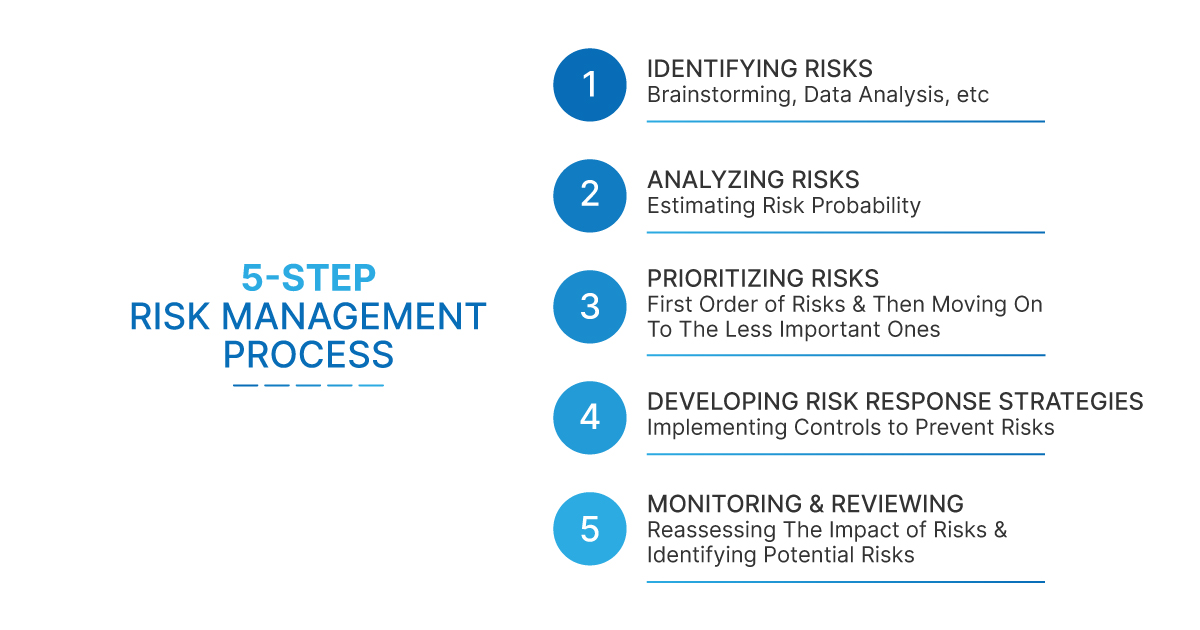Effective Risk Management Process in Project Management
The risk management process involves identifying, analyzing, and responding to potential risks in order to minimize negative impacts and maximize positive outcomes. It helps organizations make informed decisions, increase efficiency, improve financial performance, and enhance compliance and reputation.
Risk management is identifying, assessing, and mitigating risks that could impact an organization’s objectives. It involves identifying potential risks, evaluating the likelihood and impact of those risks, implementing measures to control or mitigate those risks, and ongoing monitoring and review of risks and risk control measures.
It aims to protect an organization’s assets and ensure that it can achieve its objectives, whether those are related to financial performance, operational efficiency, or compliance with laws and regulations. By identifying and addressing potential risks, organizations can reduce the likelihood of negative outcomes and increase the chances of success.
Risk management in project management involves a systematic and proactive approach to identifying, assessing, and mitigating risks. It requires using tools and techniques such as probability analysis, impacts analysis, and risk scoring to evaluate risks and determine the appropriate risk control measures. It also involves effective communication and collaboration among stakeholders, including management, employees, customers, and regulators.
Check out: Online Project Management Courses and Certifications
Let’s explore the risk management process and how it is done.
Table of Content
- Risk Management Process
- Benefits of a Risk Management Process
- 5-Step Risk Management Process
- Risk Management Evaluation
Risk Management Process
The risk management process involves identifying, analyzing, and responding to risks in order to minimize the impact of negative events and maximize the likelihood of positive outcomes.
Best-suited Project Management courses for you
Learn Project Management with these high-rated online courses
Benefits of a Risk Management Process
A risk management process can provide numerous benefits to an organization or project, including:
- Improved decision-making: By identifying and analyzing risks, an organization can make more informed decisions about how to proceed with a project or course of action. This can help avoid costly mistakes and ensure that resources are used effectively.
- Increased efficiency: A risk management process can help identify and address potential issues before they become problems, which can help increase efficiency and avoid delays.
- Improved financial performance: By identifying and mitigating risks, an organization can reduce the likelihood of financial losses and improve its financial performance.
- Enhanced reputation: A risk management process can help an organization demonstrate its commitment to safety, quality, and compliance, which can enhance its reputation and build trust with stakeholders.
- Improved stakeholder relations: By involving stakeholders in the risk management process, an organization can build trust and improve relationships with customers, employees, and other stakeholders.
- Increased compliance: A risk management process can help an organization meet regulatory and legal requirements, which can reduce the risk of fines, penalties, and legal action.
Overall, a risk management process can help an organization or project operate more efficiently and effectively, while minimizing the impact of negative events and maximizing the likelihood of positive outcomes.



5-Step Risk Management Process
The risk management process typically involves the following steps:
Identify the Risks
The first step in risk management is to identify the potential risks that may affect an organization or project. This can be done through brainstorming sessions, data analysis, or other methods.
Examples of risks that may be identified include:
- A supplier failing to deliver raw materials on time, which could disrupt production.
- A natural disaster damaging company facilities, which could result in lost revenue and increased expenses.
- A key employee leaving the company, which could result in lost expertise and productivity.
Analyze the Risks
Once the risks have been identified, they should be analyzed in order to determine their likelihood and potential impact. This may involve estimating the probability of a risk occurring and the potential consequences if it does occur.
For example:
- The likelihood of a supplier failing to deliver raw materials on time may be assessed as low if the supplier has a good track record of meeting deadlines. The potential impact of this risk may be assessed as moderate, as it could result in minor production delays.
- The likelihood of a natural disaster occurring may be assessed as moderate, as it depends on the location and type of disaster. The potential impact of this risk may be assessed as high, as it could result in significant damage to company facilities and loss of revenue.
- The likelihood of a key employee leaving the company may be assessed as high if the employee has received a job offer from a competitor. The potential impact of this risk may be assessed as moderate, as it could result in lost productivity and the need to spend resources on finding and training a replacement.
Prioritize the Risks
After the risks have been analyzed, they should be prioritized based on their likelihood and potential impact. This will help determine which risks need to be addressed first and which can be managed through monitoring and contingency planning.
For example
- A risk with a high likelihood and high potential impact, such as a natural disaster, may be prioritized as high.
- A risk with a low likelihood and low potential impact, such as a supplier delivering raw materials a few days late, may be prioritized as low.
Develop Risk Response Strategies
Once the risks have been prioritized, appropriate risk response strategies should be developed in order to mitigate or manage the risks. This may involve implementing controls or procedures to prevent the risk from occurring, transferring the risk to another party, or accepting the risk and developing contingency plans.
For example:
- Implementing a disaster recovery plan to minimize the impact of a natural disaster.
- Negotiating a contract with a supplier that includes penalties for late delivery of raw materials.
- Hiring a recruiter to identify potential candidates in case a key employee leaves the company.
Monitor and Review
Risk management is an ongoing process, so it is important to regularly monitor and review risks in order to ensure that they are being effectively managed. This may involve updating risk response strategies as needed, reassessing the likelihood and impact of risks, and identifying new risks that have emerged.
For example:
- A company may review its disaster recovery plan annually to ensure that it is still relevant and effective.
- A company may monitor the performance of its suppliers to ensure that they are meeting their obligations and taking steps to prevent delays.
- A company may regularly review its succession planning efforts to ensure that it has a pipeline of talent in case of key employee departures.
Risk Management Evaluation
Risk management evaluation is the method of assessing the effectiveness of risk management activities and identifying areas for improvement. It involves reviewing the risk management process, analyzing the results of risk management activities, and determining the impact of risks on an organization or project.
Steps involved in the risk management evaluation process:
- Review the risk management process: The first step in risk management evaluation is to review the risk management process to ensure that it is being followed consistently and effectively. This may involve reviewing the risk management plan, policies, and procedures to ensure that they are up to date and being followed.
- Analyze the results of risk management activities: The next step is to analyze the results of risk management activities, such as risk assessments, risk response strategies, and contingency plans. This may involve reviewing data on risks that have occurred, the impact of those risks, and the effectiveness of the risk response strategies.
- Determine the impact of risks: It is important to determine the impact of risks on an organization or project, including the financial and operational impacts. This can help identify areas where risk management efforts have been effective and areas that may need improvement.
- Identify areas for improvement: Based on the results of the risk management evaluation, it may be necessary to identify areas for improvement in the risk management process. This may involve updating the risk management plan, revising policies and procedures, or implementing new risk response strategies.
- Communicate the results: The results of the risk management evaluation should be communicated to relevant stakeholders, including management, employees, and other stakeholders. This will help ensure that the risk management process is understood and supported by all parties.
In conclusion, the risk management process is an ongoing process that helps organizations identify, assess, and address risks in a systematic and proactive manner. By following this process, organizations can better protect their assets and achieve their objectives.
Top FAQs on Risk Management in Project Management
What is Risk Management in Project Management?
Risk management in project management is the process of identifying, assessing, prioritizing, and mitigating potential risks and uncertainties that could impact a project's objectives.
Why is Risk Management Important in Project Management?
Risk management is crucial because it helps project managers proactively address and minimize potential issues, ensuring that projects stay on track, within budget, and meet their goals.
What are the Key Steps in Risk Management?
The key steps in risk management include risk identification, risk assessment, risk prioritization, risk mitigation planning, risk monitoring, and risk response execution.
How Do You Assess Risks in Project Management?
Risks are assessed by evaluating their likelihood of occurrence and their potential impact on the project's objectives. This assessment helps prioritize risks.
This is a collection of insightful articles from domain experts in the fields of Cloud Computing, DevOps, AWS, Data Science, Machine Learning, AI, and Natural Language Processing. The range of topics caters to upski... Read Full Bio




